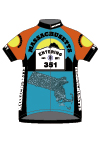In April 2022, Mike traced the march route of Civil War General William T. Sherman, using the effort to raise more than $30 thousand for cancer research at Dana-Farber as a supplement to his regular Pan-Mass Challenge (PMC) fundraising. Donations, large and small, are welcomed and can be made via this link.
Mike's route took him from Chattanooga, TN through Atlanta finishing in Savannah, GA. Eight days and 600+ miles on the road -- filled with history and exploration.
History lesson: Five weeks after leaving Atlanta, Sherman's army of 50,000 men neared Savannah and the sea. Waiting for him was a Confederate force of 10,000. Sherman's first priority was to establish contact with the Union fleet blockading Savannah. Doing so required taking control of Fort McAllister, which guarded the Ogeechee River entrance to the harbor. Fort McAllister was an earthen fort, designed to withstand naval bombardment. It had successfully defended the harbor entrance from the Union fleet for three years. But -- its cannons faced the harbor, and its garrison numbered only 200. Sherman sent a division of 4,000 to storm the fort. Given the vast numerical advantage, they captured it in 15 minutes.
The war had four months to run. Sherman followed the Rebels into South Carolina, laying waste there as he had in Georgia. But, he was magnanimous in victory, offering generous surrender terms to General Johnston and his men. After the war, Sherman served for fifteen years as the Commander of the US Army. When Republican power brokers sought him to succeed Grant as President, he famously noted, "If nominated, I will not run, if elected, I will not serve." On his death in 1891, Confederate General Johnston, who Sherman chased through Tennessee, Georgia, and the Carolinas, traveled to his funeral, and on a cold, winter day stood bareheaded in the rain. When someone suggested the 84 year old Johnston should put a hat on, he said "If I were in his place, and he were standing here in mine, he would not put on his hat". Johnston caught pneumonia that day and died a few weeks later.
Sherman -- an American original.
Like Sherman, I needed to see Fort McAllister before heading into Savannah, even though it added 30 miles to my trip. For decades, the fort was forgotten. But in the 1920s, Henry Ford starting buying property in the area, and discovered that part of what he had acquired was the site of a Civil War fort. Since couldn't transport it to the Henry Ford Museum (a must see if you are in Michigan!), he restored it in situ, and after his death it passed to the State of Georgia. Definitely worth a visit if you are in the area.
It had been thirty years since I visited Savannah, and I was blown away with the change. The sleepy Southern town I remembered (and, was described in "Midnight in the Garden of Good and Evil") felt like Mardi Gras on Friday night -- the Riverwalk was crowded and festive, seemingly every adult with an open container. And, an amazing cross-section of multi-racial and multi-cultural. Young people doing "glamshots" with the river in the background. Grandparents with tweens and young teens. Families with young children. I asked my Uber driver the next morning -- he confirmed that is routine Savannah Friday -- party town.
I thought during the day: "what have I taken away from this experience?".
- I was welcomed far more as a Yankee and an outsider than I expected. One example: my next to last day, having lunch, I was seated next to a pair of locals. We got talking, and then I asked them thoughts on the road ahead. They told me there was a better way than the main road, got out their phones, walked me through it -- and I had a much better afternoon than I otherwise would have. Meet people on their own terms -- we are far more alike than different.
- I expected to see political signs and Confederate symbols with regularity -- and I did not. Thankfully.
- That being said, there remain "black parts of town" as I saw in Dublin and Atlanta, and -- as we have in Boston. Confederate symbols adjoin courthouses, as I described in Eatonton and also observed in Statesboro. There are places like Cullman County where blacks still don't feel welcome. Karen, my host in Eatonton, and I debated "are things getting better?". And we both agreed -- yes, just not as fast as they should be. Today's MLK doesn't have to give up his seat on a bus, doesn't attend a segregated school and doesn't face intimidation at the polls. But -- we are far from a colorblind society, as I experienced in my own emotions this week.
What I saw in Savannah is the best model for what we should aspire to. The closest thing I saw to the "Melting Pot" that to me has always been the soul of what America is, or should aspire to be.
Thank you for going along with me on the this adventure! It made it so much more meaningful to me to be able to share it with you! My last takeaway -- I love this kind of adventure ride -- I will be back again doing something similar next year!
600 miles -- Chattanooga to Savannah
Georgia Low Country - Spanish Moss & Palmetto
Georgia Bikepath - not bike friendly!
Fort McAllister Bombproof
Hot Shot Cannon Fort McAllister
Haitian Volunteers freeing Savannah from British
Savannah Slavery Monument
Fried Green Tomatoes - awesome!

